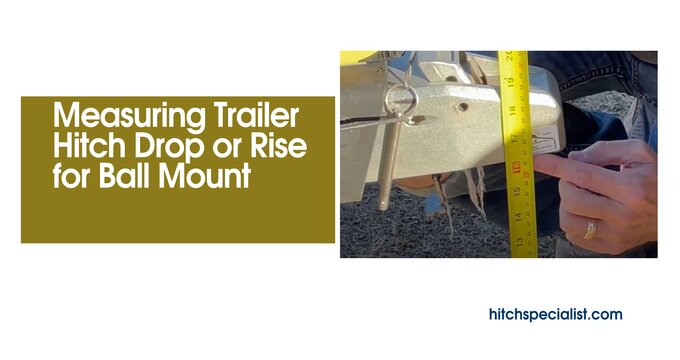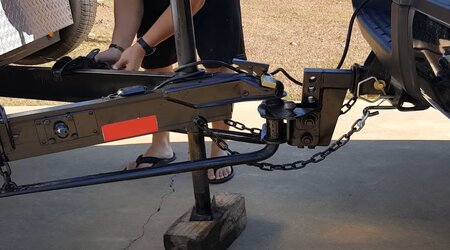
If you are confused between hitch rise and drop, and how to calculate and complete this operation properly then you are in the right place. We’ll try to cover up all you need. The trailer should constantly be brought up to tow level for safe and pleasant towing.
The tongue of a trailer can sometimes be higher or lower than the vehicle’s ball mount. To level, the trailer in this condition, a ball mount with a “Rise” or “Drop” is required.
Ball mounts are available in a variety of lengths and can be utilized in both drop and rise positions. When choosing a ball mount, make sure to check the weight rating; it should be equal to or more than the hitch you’ll be using.
So, let’s talk about its importance and give you the necessary guidelines. Keep reading the article properly and don’t miss any steps.
Importance of measuring trailer hitch drop
Measuring the trailer hitch drop is very important. Your trailer should always be as level as possible for safe and comfortable hauling. A level trailer is easier to maneuver, promotes even tire wear, and reduces pressure on both the trailer and the towing vehicle.
Otherwise, it can create a disbalance between your car and the trailer. With so many various tow vehicles and trailers on the market, it’s uncommon that any car and trailer will tow smoothly.
This is why ball mounts come in several sizes and include e rise and drop to compensate for the height difference between your trailer and car and ensure safe, level towing.
How much drop do I need on my trailer hitch?
Different trailers need different drops. Better is to determine it by yourself. To determine the height of the trailer hitch ball, Subtract the distance between the ground and the top of your hitch receiver from the distance between the ground and the bottom of the trailer coupler.
For example: 20″ Hitch Height – 15″ Coupler Height = 5″ Drop Needed
How to measure trailer hitch drop or rise?
When towing, it’s always important to think about safety first, and then do what’s necessary to have a comfortable pull and ride. The most important element here is that the trailer is hauled as level as possible so that you can accomplish both objectives. Because the towing vehicle is occasionally taller than the trailer, and for that, drop or rise hitches are required.
When the ball mount is positioned for greater coupler height, the rise is the distance between the top of the shank and the top of the ball platform. When the ball mount is positioned for reduced coupler height, the drop is the distance between the top of the shank and the top of the ball platform. Now let’s talk about some measurements.
You’ll need to take two measurements before you can properly determine a ball mount height. Measurement A is the height of your hitch, and Measurement B is the height of your coupler. This calculation’s difference will give you the correct rise or drop.
Steps
- Measurement A: Determine the height of your hitch. Measure from the ground to the very top of your hitch receiver opening with the tow vehicle parked on level ground.
- Measurement B: You’ll need to measure from the ground to the bottom of the coupler with the trailer level.
- Finding differences: Use a ball mount with a drop if your hitch height is higher.
Drop (C) = Hitch Height (A) − Coupler Height (B)
Use a ball mount with a raise if your coupler height is higher.
Rise (D) = Coupler Height (B)- Hitch Height(A)
Now Choose a ball mount with the correct drop (C) or rise (D) measurement that corresponds to the height difference between the hitch and the coupler. For instance, if your hitch height is 12 inches and your coupler height is 8 inches, you’ll require a 4-inch drop ball mount.
C (5′′ Drop) = Measurement A (15′′) – Measurement B (10′′).
You’ll need a ball mount with a 4-inch rise if your hitch height is 10 inches and your coupler height is 14 inches.
D (2′′ Rise) = Measurement B (15′′) – Measurement A (13′′)
Try to maintain these calculations and guidelines properly. Otherwise wrong measurements may create a disbalance which can cause accidents as well.
Things you should keep in mind during the measurement
During this operation, there are several things that you need to fulfill this work without any irritating inconvenience.
Flat ground: You need a ground that is flat so that you can measure the heights easily and that will be equally distributed as well.
Park the trailer and vehicle properly: You’ll need the trailer and the tow vehicle, both of which should be parked on level ground. It will be best if the tow vehicle and trailer are filled with stuff that is similar to what would be required for the journey, as this will allow you to get an exact measurement.
The trailer must be parked on the ground level, with the tongue propped up to the proper height using the kickstand.
Tape measure: A measuring tool will be required of you. A tape measure is the greatest instrument to have for these types of measures. If you don’t have access to a tape measure, a ruler or a square should suffice.
N.B. If you face any kind of difficulties as a first-timer, in this case, it is advised to take the help of a partner, especially one who has experience in these operations.
What is the most common hitch drop?
We generally recommend a minimum of 9-11″ space between the bottom of your LOADED trailer hitch ball mount and the ground. You can avoid scraping the bottom of your hitch on bumps, dips, and slanted driveways with that 9-11″ of clearance.
Please keep in mind that this is just a suggestion, and other factors such as the quality or tension strength of your vehicle’s shocks may alter the distance between the ground and the bottom of the hitch.
Trailer Hitch Drop and rise measurement video guideline
FAQs:
Is it ok if your trailer hitch is too high?
Properly connecting a travel trailer to a tow vehicle might be difficult. There are other variables to consider, as well as little tweaks to make. However, taking your time and being meticulous is worth it! You’ll have a hard time pulling your trailer if your hitch is placed too high or too low, and it won’t be safe to drive.
A hitch that is too high is likewise risky. The hitch will lean backward if it is too high for the travel trailer, resulting in a sloping profile and unequal weight distribution. As a result, you’ll be less aerodynamic, and your trailer will be more prone to catch the wind and swing.
Trailer sway is nothing to joke at, and it has resulted in numerous fatalities. Hope you got your answer.
Is it OK to flip a tow hitch?
You’re okay to proceed if the tow bar and tow tongue manufacturers, as well as the car manufacturer, agrees. Make sure it doesn’t touch anything and doesn’t change the weight of your tow ball, and you’ll be ok.
But nowadays a vast majority of common ball mounts are intended to work in both the drop and rise positions.
What size drop hitch do I need for a 6-inch lift?
A drop hitch, such as the 180 Hitch 2-Ball Mount w/ Stainless Steel Balls – 2″ Hitch – 10″ Drop # LTB10-2, is required when a truck has a 6-inch lift. Measure from the ground to the inner top of the receiver opening and then from the ground to the bottom of your trailer coupler to establish the exact drop you require. As you deduct those two dimensions, you’ll get the drop you need. To help, We’ve written an article and linked all of the drop hitch ball mounts.
N.B. If you’re using the 180 Hitch ball mount, you might want to consider utilizing the Locking Dual Pin Assembly and Hitch Pin Set for 180 Hitch – TowWorks 79852 to secure it and offer you a single key to adjust it as needed.
Conclusion
In the above discussion, we tried to cover up all the necessary information that people usually have in their mind and wants to clarify. These are the calculations and measurements that how you can understand your trailer hitch measurement which used to be different from another.
While running the operation try to follow all the steps properly from which you will be able to avoid any kind of accident or harmful incident on road. We tried to answer some of the common questions and if you have more please send them to us. Till then stay safe and have a good journey!
Other related topics you may want to read:




